Two Portraits & Serendipitous Friendship
Their friendship was uncannily serendipitous. They were fellow artists, authors, seekers of truth on a similar path, and for quite some time they lived here, across the street from each other on West 10th Street in Greenwich Village.
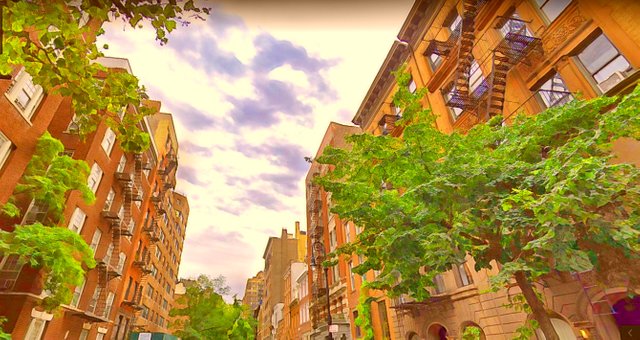
From 1908 to 1910 the Lebanese-American poet/painter/author Khalil Gibran had studied painting in Paris at the Académie Julian. In 1912 was 29 years old and had moved from Boston to New York City to establish himself in the art community. Another 11 years would pass before his book “The Prophet” was published.
In 1912 a Syrian acquaintance convinced the artist Juliet Thompson to visit Khalil Gibran's gallery. At this time she was 39 and already an established portraitist who had painted the First Lady in the White House. She liked Gibran's art, especially his drawings, and remarked that his art “made her heart weep.” Her comment touched him, especially given her stature at that point relative to his. Later in life she would describe his art this way: “His drawings were more beautiful than his paintings. These were very misty, lost things — mysterious and lost. Very poetic.”
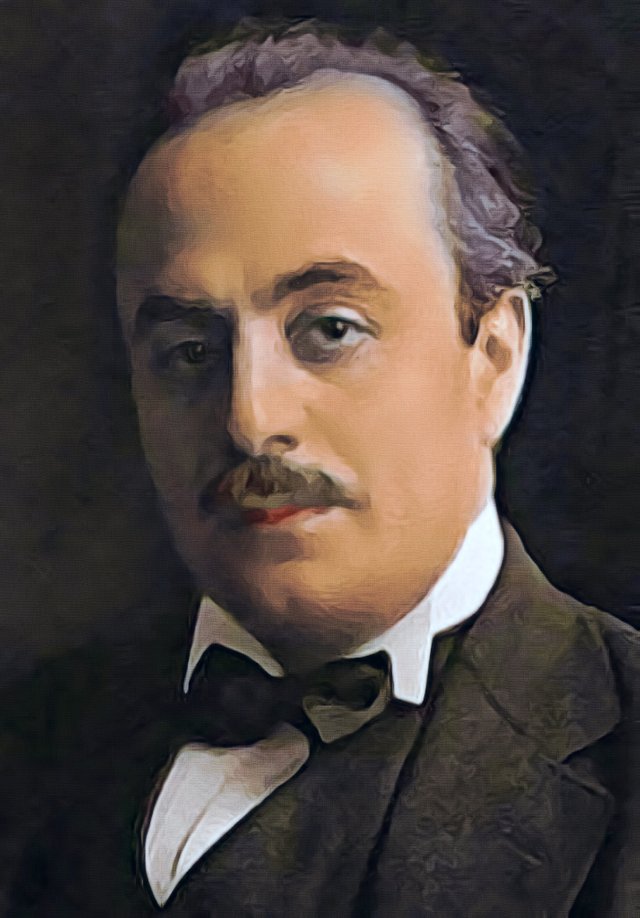
Khalil Gibran
Juliet recounted her memories of Khalil to the authorMarzieh Gail:
"He was neither poor nor rich — in between. Worked on an Arab newspaper; free to paint and write.”
"He was in love with a friend of mine — but he just loved me, and I loved him — but it wasn't that kind of love. He just wasn't a lover. He wasn't that kind of a man. He had a high, delicate voice and an almost shyly modest manner, until he came out with something thundering. He wore American business clothes. Had lots of black hair, wavy.”
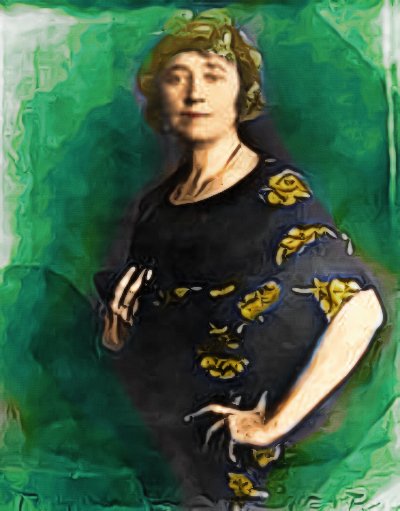
Juliet Thompson
Juliet on the other hand was gregarious, charismatic, and could be stunningly direct in her honesty.
“I don't know how to describe him except to say he was the spitting image of Charlie Chaplin. I used to tell him so. It made him frightfully mad. Large, tragic brown eyes. The eye was very important in his face. His forehead was broad — very high — very broad, and he had almost a shock of black hair. Short, slender, five foot two or three. Very sensitive mouth drooped a little at the corners. Very sad man who had a reason for it. Little black moustache, like Charlie Chaplin.”
Although her honesty could be jolting, her honest opinions were clearly appreciated by Khalil and others.
“Kahlil always said I was his first friend in New York. We became very, very great friends, and all of his books — The Madman, The Forerunner, The Son of Man, The Prophet — I heard in manuscript. He always gave me his books. He wrote his books in the studio across the street. Then he would call me up and say come over and hear a chapter.”
Serendipity
In 1911, a year prior to meeting Juliet, Khalil had drawn a portrait of the poet W.B. Yeats, which was to be the first portrait in what he would later call the “Temple of Art” series which, among others, would eventually include: Claude Debussy, Auguste Rodin, Sarah Bernhardt, Charles Russell, Carl G Jung, and (thanks to Juliet) 'Abdul-Bahá.
Not only were Juliet and Khalil portraitists and writers, but they were both drawn to the Arab and Persian culture, mysticism, and spirituality. Moreover, they both believed in the fundamental unity of religions. Juliet had been a Bahá'i for over ten years, and was among an early group of American believers who had made a pilgrimage in 1909 to the Holy Lands where she met Abdul-Bahá.
As their friendship grew she eagerly shared what she had learned and experienced with Khalil, and he listened attentively. He then got hold of some of the Bahá'i sacred writings in the original Arabic. The founder of the Bahá'i Faith, Bahá'u'lláh, was the son of a Persian nobleman, and although Persian was his primary language, he also revealed some of his revelation in Arabic. Juliet described Khalil's reaction:
“He got hold of some of the Arabic of Bahá'u'lláh. He said was the most stupendous literature that ever was written, and that He even coined words. That there was no Arabic that even touched the Arabic of Bahá'u'lláh.”
That statement is all the more remarkable given the fact that Gibran's Arabic poetry had been deemed “perhaps the most beautiful in modern Arabic," and “a wonderful work of art” in the Arab press. See Kahlil Gibran: Man and Poet by Suheil Badi Bushrui and Joe Jenkins, Oxford: Oneworld, 1998
Now by a bit of kismet, Khalil learned from Juliet that Bahá'u'lláh's son, 'Abdul-Bahá, soon would be arriving in New York on a trip to North America to visit the nascent Bahá'i communities and to proclaim his father's message to the West. Juliet's request to paint a portrait of the Master, as 'Abdul-Bahá was called by Bahá'is, had already been granted. Khalil asked her if she would request that he also sit for him. And so it was that these two newfound friends each did portraits of 'Abdul-Bahá. Juliet's account:
“The Master gave him one hour at 6:30 one morning... He'd never met the Master before, and that began his friendship. He simply adored the Master. He was with Him whenever he could be. He would come over here to this house (48 West 10th) to see the Master. In Boston, he was often with the Master. All that's sort of blurred because it's so long ago...
From the book, “This Man from Lebanon: A Study of Kahlil Gibran” by Barbara Young (New York: Knopf, 1945) we get a bit of Khalil Gibran's account:
"In his later years he liked to talk about the years in Paris and the early years in New York, of his first studio, which he called 'my little cage' and then the spacious one, higher up in the building, a great room where he felt a new freedom, where he said, 'I can spread my wings.' It was in this studio that the drawing was made of the revered 'Abdu'l-Bahá in 1912. The saintly man had indicated that seven in the morning was the hour at which we would consent to sit for his portrait. Telling about it, Gibran said 'I remained awake all night, for I knew I should never have an eye or a hand to work with if I took my sleep.'" p. 68
Impressions
Before sharing the actual portraits, here is a pen-portrait of 'Abdu'l-Bahá written by Professor Edward Granville Browne of the University of Cambridge. Browne was an orientalist and historian, fluent in Arabic, Perisan, and Turkish, and one of the few Western people to have met the founder of the Bahá'i Faith. This occurred in 1890, two years prior to his death in 1892. To prevent the spread of the Baha'i Faith in Persia, he had been imprisoned in 1853 and then exiled in Iraq, Turkey, and finally to the prison city of Akka in what is today Israel. At the time of Professor Browne's visit he had been released from prison and placed in house arrest. Thus Professor Browne's pen-portrait of Bahá'u'lláh is of considerable historic significance, if you are interested you can listen to an audio version here.
During that same trip he also met the Master and gave us this pen-portrait of the then 46 year old 'Abdu'l-Bahá:
“Seldom have I seen one whose appearance impressed me more. A tall strongly-built man holding himself straight as an arrow, with white turban and raiment, long black locks reaching almost to the shoulder, broad powerful forehead indicating a strong intellect combined with an unswerving will, eyes keen as a hawk’s, and strongly-marked but pleasing features–such was my first impression of ‘Abbas Effendi, “the master” as he par excellence is called…. One more eloquent of speech, more ready of argument, more apt of illustration, more intimately acquainted with the sacred books of the Jews, the Christians, the Muhammadans, could, I should think, scarcely be found even amongst the eloquent, ready, and subtle race to which he belongs. These qualities, combined with a bearing at once majestic and genial, made me cease to wonder at the influence and esteem which he enjoyed even beyond the circle of his father’s followers. About the greatness of this man and his power no one who had seen him could entertain a doubt.”
Khalil Gibran's Portrait
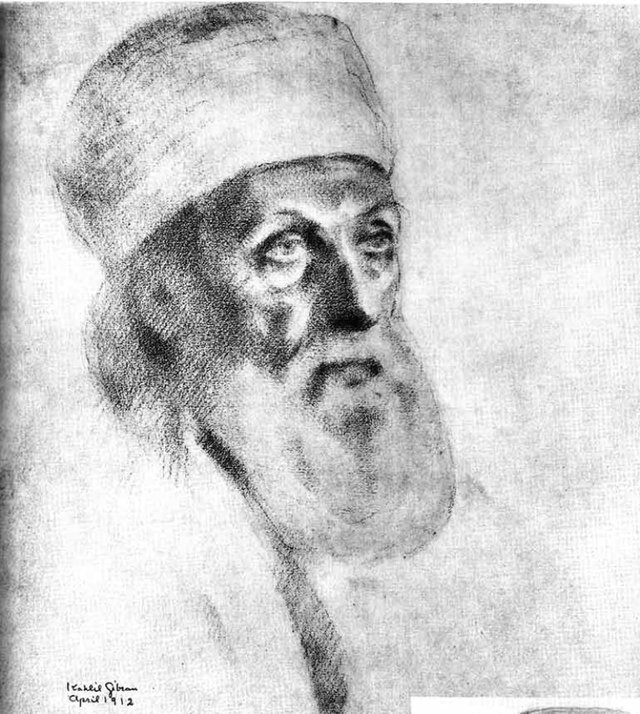
Above is Khalil Gibran's portrait of the 68 year old 'Abdu'l-Bahá
Particularly noteworthy was how Khalil Gibran captured his eyes in this quick sketch. Although it is rare among Persians, both 'Abdu'l-Bahá and his sister had piercing blue eyes.
Here's a b/w photo and my colorized version
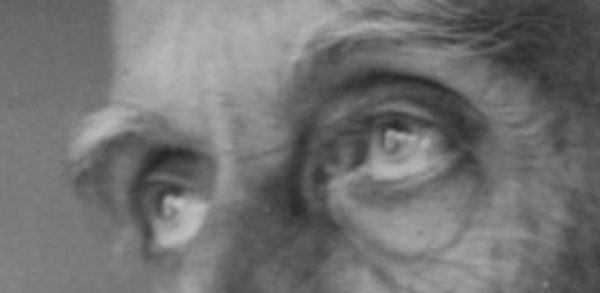
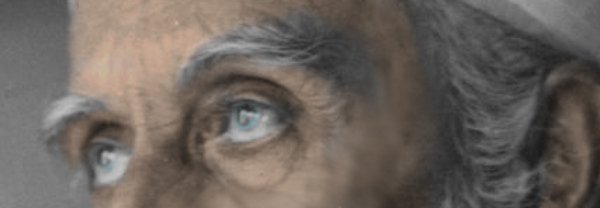
Professor Suheil Bushrui in his book Kahlil Gibran: Man and Poet, Oxford Press provides an even more in depth account that cites letters between Gibran and Mary Elizabeth Haskel (Gibran's one-time fiancee, close friend and patron.)
It was with great anticipation then that Gibran awaited the fruition of Juliet's plans to arrange a sitting, and he wrote to Mary: "I must draw 'Abdu'l-Bahá. His portrait is as necessary to my series as that of Rodin." Mary reassured him: "He will be drawn by you — he will understand your series and you, and it will be his pleasure as well as yours."
Gibran met and talked with 'Abdu'l-Bahá three times before the sitting, even acting as his interpreter for the many visitors who flocked to see their Master. Gibran said of him: "He is a very great man. He is complete. There are worlds in his soul. And oh what a remarkable face — what a beautiful face — so real and so sweet."
Finally a sitting was arranged on Friday April 19 at seven-thirty in the morning, yet despite the "early hour," Gibran felt sure he was capable of "making a great drawing of him." The artist slept badly the night before, sensing the air charged with the horrible sea tragedy of the White Star liner Titanic which had sunk on April 14-15 off the Grand Banks of Newfoundland with the loss of 1,513 lives. He began his work at eight, and after an hour the twenty-five people in the room began to shake his hands, saying: "You have seen the soul of the Master." 'Abdu'l-Bahá then spoke to Gibran in Arabic: "Those who work with the Spirit work well. You have the power of Alláh in you," and, quoting Mohammed, said: "Prophets and poets see with the light of God," Gibran recording that in 'Abdu'l-Bahá's smile "there was the mystery of Syria and Arabia and Persia."
According to Juliet, Khalil Gibran's later work was influenced by 'Abdu'l-Bahá:
“He always gave me his books. I liked “The Prophet” best. I don't believe that there was any connection between 'Abdu'l- Bahá and “The Prophet”. But he told me that when he wrote “The Son of Man” he thought of 'Abdu'l-Bahá all through. He said that he was going to write another book with 'Abdu'l- Bahá as the center and all the contemporaries of 'Abdu'l-Bahá speaking. He died before he wrote it. He told me definitely that “The Son of Man” was influenced by 'Abdu'l-Bahá.”
“Poor Kahlil! The end isn't so good. I was away. When I came back he was very sick. He asked me if I wouldn't come every day to see him. He was in bed. These were his last days. I want to give you all I can while I can. He would pour out the story of his life...”
Juliet Thompson's Portrait
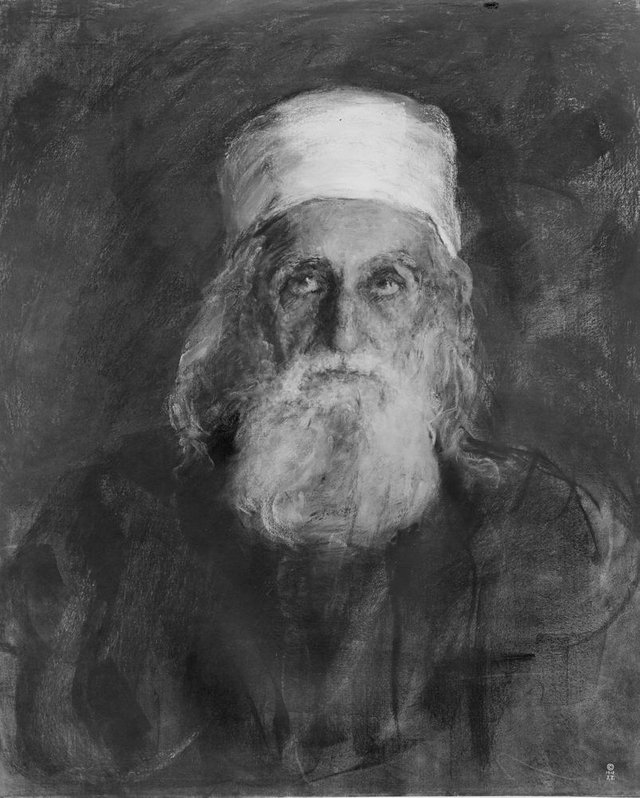
Here is an account from the book, “ ‘Abdu’l-Bahá in Their Midst”, by Earl Redman, p. 138-139
“On 1 June, Juliet Thompson went to the Master to begin painting His portrait. When she arrived He asked, “Can you paint Me in a half hour?” “A half-hour, my Lord?” I stammered, appalled. “I can never finish a head in less than two weeks.” “Well, I will give you 3 half hours. You mustn’t waste My time Juliet.” He told me to come to Him Saturday morning, June 1, at 7:30.”
I went in a panic. He was waiting for me in the entrance hall, a small space in the English basement where the light – not much of it – comes from the South. In fact, I found myself faced with every kind of handicap. I always paint standing, but now I was obliged to sit, so close to the window (because of the lack of distance between the Master and me), that I couldn’t even lean back. No light. No room. And I had brought a canvas for a life-size head.”
The Master was seated in a dark corner, His black ‘abá melting into the background; and again, I saw Him as the Face of God, and quailed. How could I paint the Face of God? “I want you", He said, “to paint my servitude to God.” “Oh my Lord", I cried, “only the Holy Spirit could paint Your servitude to God. No human hand could do it. Pray for me, or I am lost. I implore you, inspire me.” “I will pray", He answered, “and as you are doing this only for the sake of God, you will be inspired.”
And then, an amazing thing happened. All fear fell away from me and it was as though Someone Else saw through my eyes. Worked through my hand. All the points, all the planes in that matchless face were so clear to me that my hand couldn’t put them down quickly enough, couldn’t keep pace with the clarity of my vision. I painted in ecstasy, free as I had never been before. At the end of the half-hour the foundation of the head was perfect.
Sadly Juliet Thompson's original portrait was lost, all we have is the b/w photograph above. To me it seems she fulfilled his request. She captured his servitude and Khalil Gibran revealed his inner beauty.
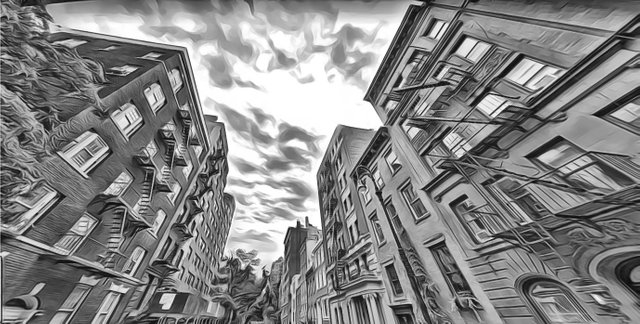
Credits
Photographs of Khalil Gibran and Juliet available on multiple sites, copyright unknown, colorized with effects by @roused
Basis Photograph of West 10th Street originally from Google maps, cropped with effects by @roused
Sources
Professor Bushrui on Khalil Gibran
Juliet Thompson on Khalil Gibran
Pen-portraits by Professor Browne
Bahá'i Background Information
.
I never heard of any of them so it is really fascinating for me. What a story and what a wonderful style Juliet Thompson has in her letters.
Thanks, I know you are busy and this was a long post, so I appreciate you taking the time. I have one final post about Juliet, in the next one she encounter the "father of abstract expressionism" :-)
Crazy you even write that, but I do understand. I can see it in my children that they simply have to make a greater effort to read than we did. We are bombarded with politics, information, and entertainment all the time.
I tend to choose my battles and then I stop looking while working. The whole weekend has gone by with me arguing with my youngest daughter, cycling more than 50 kilometres, seeing some family, and getting up in the night because both girls were ill :) I enjoyed reading about these highly spiritually over-sensitive people from a hundred years ago. They would never consider a small text like this cumbersome!
So sorry your girls are ill, I hope they recover soon and are ready to cycle again this coming weekend.
You're absolutely right about the people from that era, I so admire their social grace and eloquence.
Well, in the end I got the same flu like cough and snotty nose - and my wife too actually.
There was always an admiration for the past (the Romans had their gold age too), but admiration is educative I think.